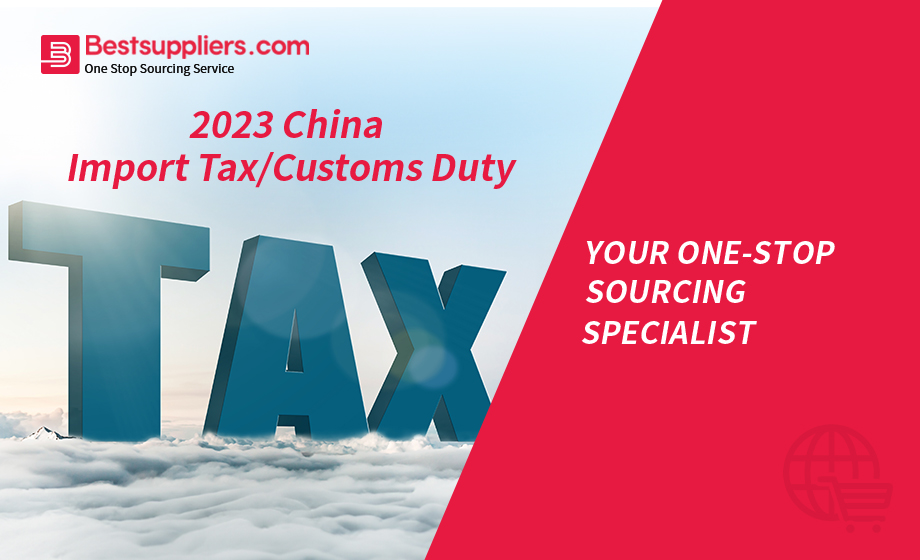2023 China Import Tax/Customs Duty

Introduction:
The world of international trade is dynamic and ever-changing, and China has long been a central player in global commerce. Businesses engaging in import operations with China must be well-versed in the intricacies of customs duties and taxes.
The Chinese government levies an import tax, commonly referred to as a customs charge, on commodities that are brought into the nation. Based on the type of goods and the country of origin, it is determined as a percentage of the product's value. Some nations will apply different tax rates to the same items coming from different nations, creating a sort of unequal treatment, depending on the demands of political and economic relations.
With the relaxation of all COVID-19-related policies in the first ten days of January 2023 China got off to a terrific start for the global business community. It's time to break some good news to international exporters and multinational corporations involved in trade with China. The primary categories susceptible to newly reduced tariff rates are shown below, along with a summary of the most recent import and export tariff modifications. Can your business benefit from these changes? Could this be a wise time for your company to expand into the Chinese market? Go on reading.

Customs Duties: Types
Customs duties encompass a range of taxes levied on imported goods at the point of entry into a country. Below are the types of customs duties:
MFN/ Most Favored Nation:
Regardless of the nation of origin, all commodities are subject to the MFN tariff, which is the standard tariff rate for the majority of goods unless a preferential tariff rate or an exemption applies.
Preferential Tariff:
The items imported from nations with which China has a preferential trade agreement may be subject to a reduced import tax rate. Depending on the conditions of the trade agreements in existence, different items and nations may qualify for preferential tariffs.
Antidumping Taxes:
It is a further import tax that may be applied to goods that are offered for sale in China at a discount to their normal price in the place of origin. The intention is to stop foreign businesses from dumping inexpensive goods on the Chinese market and harming homegrown firms.
CVD/ Countervailing Duty:
This is an additional import tax that may be imposed on goods that receive foreign government subsidies. It is generally levied on products that are the subject of anti-dumping investigations, and it is determined by the amount of subsidy that the foreign firm gets. The CVD is typically set at a rate equal to the subsidy amount and varies based on the product and the country of origin.
Consumption Tax for Goods Imported:
Certain commodities that are consumed domestically in China are subject to consumption tax. Both domestically manufactured commodities and imported goods are subject to this tax. For example non-renewable resources, high-end luxury items, alcoholic beverages, and tobacco products.
Value Added Tax (VAT):
A tax is imposed on the incremental value added at each stage of the supply chain, ensuring that businesses pay tax on the value they contribute.
Customs Duty:
A duty is imposed on imported goods to protect domestic industries, regulate imports, and generate revenue for the government.
Customs & Taxes When Importing from China: US, UK, Australia, Canada, ASEAN, Ireland & Switzerland:
Navigating the customs and tax regulations of different countries is crucial for businesses importing goods from China. Here's an overview of the customs and tax implications when importing from China into some key markets:
- United States (US): US importers must be aware of the Harmonized Tariff Schedule (HTS) to identify the applicable customs duty rates.
- United Kingdom (UK): Post-Brexit, UK importers must adhere to the UK Global Tariff (UKGT) to determine customs duties.
- Australia: Importers in Australia must comply with the Customs Tariff Act to calculate the duty rates accurately.
- Canada: The Canada Border Services Agency (CBSA) regulates customs duties, and importers can refer to the Customs Tariff for applicable rates.
- ASEAN Countries: Customs duty rates may vary across ASEAN member countries, necessitating careful consideration of individual country regulations.
- Ireland: Post-Brexit, Ireland's customs rules have changed, and importers must comply with the Irish Tax and Customs requirements.
- Switzerland: Importers into Switzerland must navigate the Swiss Customs Administration and the Harmonized System to determine customs duty rates.
Types of China Import Duty:

China imposes six main types of import duty, each catering to specific product categories and trade scenarios:
- Most-Favored-Nation (MFN) Duty Rates: The standard duty rates applied to goods from countries without preferential trade agreements.
- Conventional Duty Rates: Applicable to countries with preferential trade agreements, ensuring reduced duty rates.
- Special Preferential Duty Rates: Offered to countries with exceptionally favorable trade agreements.
- Provisional Duty Rates: Temporary duty rates imposed during investigations or trade disputes.
- Duty Paying Value for Imported Goods: The customs value used to calculate import duties.
- Anti-Dumping Duties: Imposed on goods priced lower than their domestic market value, preventing unfair competition.
What Is Customs Value?
The customs value, also known as the transaction value, is the basis for calculating customs duties and taxes. It comprises the actual cost of the imported goods, freight charges, insurance, and other related expenses incurred before the goods arrive at the importing country. Accurate determination of customs value is vital, as under-declared or misreported values can lead to penalties and customs clearance delays.
Conclusion:
In the complex realm of international trade, understanding customs duties and taxes when importing from China is essential for businesses to thrive and remain competitive in 2023. The diverse types of customs duties, including VAT, Consumption Tax, and Customs Duty, demand careful consideration during import transactions. Additionally, businesses must be well-informed about the customs and tax regulations of key importing nations, enabling smooth trade operations. By comprehending the six types of China import duty, including MNF duty rates and Anti-dumping duties, businesses can navigate the intricacies of international trade successfully. Lastly, accurately determining the customs value and addressing common FAQs will empower businesses with the knowledge they need to achieve success in the global marketplace.

